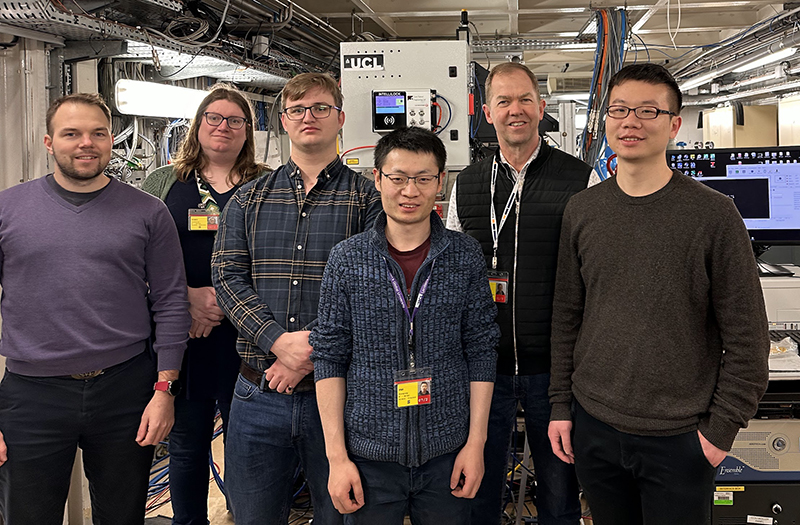- Home
- News
- General News
- Researchers find...
Researchers find a mechanism of large pore formation in additive manufacturing
26-02-2024
Scientists have observed how pores form, evolve and grow during directed energy deposition additive manufacturing (DED-AM). Using the ESRF, they discovered how dozens of small pores can coalesce to form much larger, potentially detrimental ones. These insights could lead to both AM technology improvements and higher performing final products, such as aero engine components. Their results are out today in Nature Communications.
For the so-called Industry 4.0, where intelligent production routes and advanced information technology are merged, additive manufacturing (AM) is considered as key technology. Additive Manufacturing is the technology that builds 3D objects by adding powdered material, one layer at a time, to form almost any object, regardless of its complexity. Directed energy deposition (DED) is a type of AM that focuses energy to melt blown powder onto a substrate for complex product fabrication and repair.
Today, many different products, often with intricate shapes, are manufactured using DED in aerospace, power systems, automotive and marine fields. These include the manufacturing and repair of specialised aerospace and power plant components such as turbine blades or nozzles.
However, the industrialization of DED has been limited so far, due to the porosity introduced in the process, and which can be detrimental to the components’ performance.
“Whilst this technology is already widely used, there is still not much known about how pores arise and evolve in DED, so we wanted to investigate that”, explains Peter Lee, professor at University College London (UCL) and corresponding author of the paper. Until now, porosity in DED has mostly been studied ex situ, using metallographic observation and X-ray computed tomography. “There is a strong demand in getting results with industrial-relevant conditions and at a high temporal resolution to explain these pore mechanisms”, says Martyn Jones of Rolls-Royce plc.
Lee and Zhang, together with colleagues from UCL, in collaboration with the ESRF, RMIT (Australia), Shimane University (Japan), Queen Mary University of London and Rolls-Royce plc, came to the ESRF to track pores during their formation, growth and migration in situ. They combined ultra-high speed in situ synchrotron X-ray imaging on beamline ID19 and multi-physics modelling.
On ID19, they set up a Blown Powder Additive Manufacturing Replicator, similar to the machinery used in industry except with x-ray transparent windows to enable the process to be captured ultra-high-speed synchrotron radiography. “Laser DED-AM forms new tracks of metal with solidification rates over 1000 times faster than traditional processes, requiring ultra-high speed imaging, which the ID19 and the extremely brilliant source of ESRF-EBS provides” explains Kai Zhang, UCL Research Fellow leading the experiment remotely.
“The experiment was very complex for several reasons: the nickel superalloy used, the strength of the laser and the fact that a big part of the team could not travel because it was during Covid restriction times”, explains Yunhui Chen, scientist at RMIT in Melbourne (Australia), visiting scientist at the ESRF and coordinator of the team onsite.
Prior ex situ examination of DED-AM components occasionally found large pores, which other studies suggested were formed due to instabilities in the laser keyhole. However, under most industrial DED conditions a wide laser beam is used and no keyhole is formed. This study revealed the mechanism for large bubble formation, suggesting ways to avoid them.
 |
|
Multi-institutional team of researchers on ESRF’s ID19 beamline with their in situ DED additive manufacturing rig. From left to right – Ivars Krastins (University of Greenwich), Catherine Tonry (University of Greenwich), Harry Chapman (UCL), Xianqiang Fan (UCL), Peter Lee (UCL), Kai Zhang (UCL). |
The researchers found that the pore behaviour goes through different stages: formation, bubble coalescence and growth, solid/liquid interface pushing of large bubbles, large bubble entrainment in the molten pool and finally, bubble escape or entrapment.
At first, argon bubbles from gas atomized powder enter the melt pool and move in circles or sideways. Then the small bubbles can either escape from the pool surface, become entrapped in the solidification front, or surprisingly dozens of small argon bubbles may coalesce into one or more large bubbles. Unexpectedly, the large buoyancy force driving these larger merged bubbles to the upper surface is balanced by the Marangoni surface shear flow. This is the rapid movement of fluids along a liquid surface minimising the temperature gradient driven variation in surface free energy.
Finally, once large bubbles become too big, they escape from the pool or if the solidification conditions allow it, they get trapped in the final component.
“Only using the higher flux and enhanced beam coherence of the new ESRF Extremely Brilliant Source could we replicate industrial conditions to discover that the mechanism of large pore formation is through coalescence of small argon bubbles in the feedstock”, says Lee. “The next step is to test ways of mitigating large bubble formation, such as using other feedstocks which don’t have entrained argon bubbles in them”, he concludes.
Reference:
Text by Montserrat Capellas Espuny
Top image: X-ray imaging show bubble coalescence. Credits: A. Rack.



